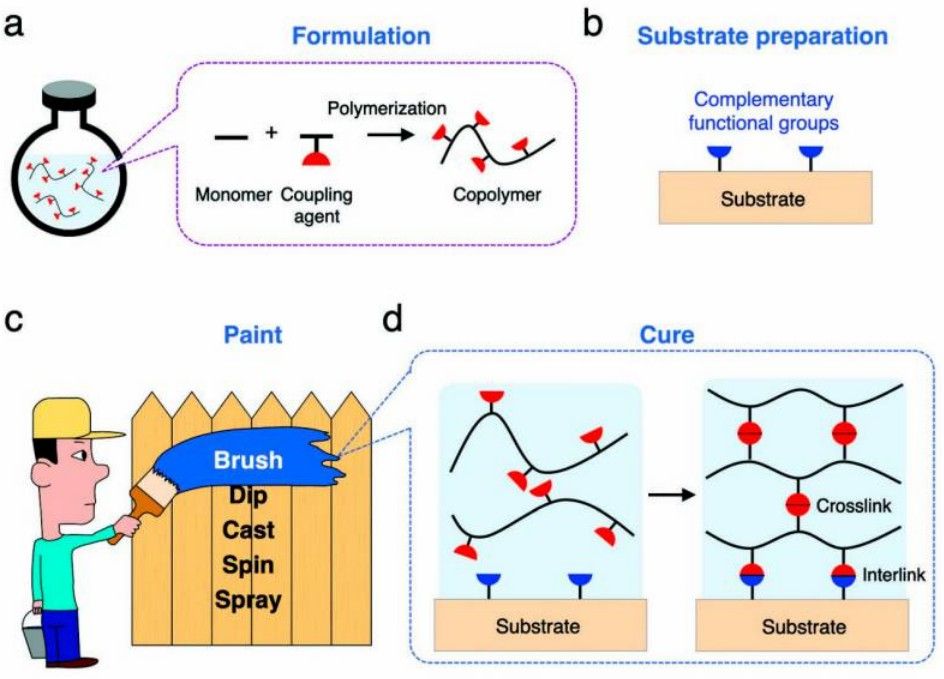Hydrogel for Coating
Hydrogel exhibits remarkable characteristics, including exceptional antibacterial properties, compatibility with living organisms, water absorption and retention capacity, swelling ability, and high oxygen permeability. These outstanding biochemical and mechanical attributes render hydrogels highly advantageous in the field of coating.
Introduction to Coating
Medical devices, such as catheters, hernia nets, implants, and wound dressings, often encounter bacterial colonization which can lead to varying levels of infection and pose a risk to patients' well-being. It is crucial to employ surface coating or modification technology that can effectively adapt to the complex physiological environment within the human body. The utilization of surface coating or modification techniques has been widely recognized as a promising approach for incorporating additional functionalities into biomaterials while preserving their inherent properties.
 Fig. 1 Surface
modification methods of medical devices. (Chen H, et al., 2023)
Fig. 1 Surface
modification methods of medical devices. (Chen H, et al., 2023)
Utilization of the Hydrogel Coating
The utilization of a biochemical modification technique, such as the integration of a functional hydrogel coating onto implants, presents notable advantages compared to physical or chemical modification approaches. This method allows for the attachment of biomolecules like proteins, peptides, growth factors, polysaccharides, or nucleotides onto the surface of the implant in order to actively participate in biological processes. Moreover, it facilitates the control of cell adhesion, proliferation, migration, and differentiation while simultaneously enhancing the biological activity on the implant's surface.
 Fig. 2 Principle of hydrogel
coating. (Chen H, et al., 2023)
Fig. 2 Principle of hydrogel
coating. (Chen H, et al., 2023)
- Hydrogel Coating in Osseointegration
The process of osseointegration involves direct interaction between the implant and bone tissue, observed through an optical microscope, without the presence of fibrous connective tissue. The application of hydrogel immobilization on the implant surface induces biochemical modifications that actively participate in biological processes. This not only allows for the replication of the extracellular matrix environment and development of bio-mimetic implants for bone defect design and repair but also serves as a carrier for the controlled release of various active substances that promote bone formation.
 Fig. 3 Hydrogel coatings on
osseointegration. (Chen H, et al., 2023)
Fig. 3 Hydrogel coatings on
osseointegration. (Chen H, et al., 2023)
- Hydrogel Coating in Angiogenesis
The presence of a sufficient amount of blood is crucial for promoting bone regeneration, and the enhancement of angiogenesis has become increasingly important in ensuring the success of implants. Hydrogel coating has the potential to act as a delivery system for drugs, growth factors, and cells, effectively stimulating the formation of new blood vessels around implants. - Hydrogel Coating in Macrophage Polarization
The dynamic and reversible nature of macrophage polarization is pivotal in the development, advancement, and result of diverse immune-inflammatory conditions such as peri-implantitis. The utilization of hydrogel to 'reprogram' macrophages presents a novel approach with the objective of enhancing the resolution of inflammation. The promotion of the M1 to M2 phenotype switch in macrophages and regulation of inflammatory response is facilitated by the incorporation of a two-component hydrogel coating containing borate ester bond and thymosin β4, which effectively eliminates excessive ROS. - Hydrogel Coating in Antibacterial
The occurrence of bacterial biofilms may cause implant infections and compromise osseointegration, leading to the loosening and detachment of implants. Hydrogels possessing exceptional biocompatibility and drug encapsulation abilities can gradually release diverse antibacterial agents to hinder initial bacterial adhesion.
 Fig. 4 Preparation of the hydrogel coatings and antimicrobial agent loading. (Peng T, et
al., 2023)
Fig. 4 Preparation of the hydrogel coatings and antimicrobial agent loading. (Peng T, et
al., 2023)
- Hydrogel Coating in Drug Delivery
Hydrogel coatings have found widespread application in various medical domains as vehicles for the controlled delivery of medications. The purpose of hydrogel coatings is to facilitate controlled and sustained drug release. The porous structure of hydrogels enables the incorporation of drugs, while their swelling behavior can be tailored to regulate the gradual release rate of the drug over a specific period.
The Hydrogel Development Services We Provide
With professional equipment and experienced specialists, Matexcel provides high-quality polysaccharide-based hydrogel development services, synthetic hydrogel development services, stimuli‐responsive hydrogels development services, and hydrogel modification services. Please contact us for more information.
References
- Chen H.; et al. Progress in Surface Modification of Titanium Implants by Hydrogel Coatings. Gels. 2023;9(5):423.
- Peng T.; et al. Antibacterial-Based Hydrogel Coatings and Their Application in the Biomedical Field-A Review. J Funct Biomater. 2023;14(5):243.